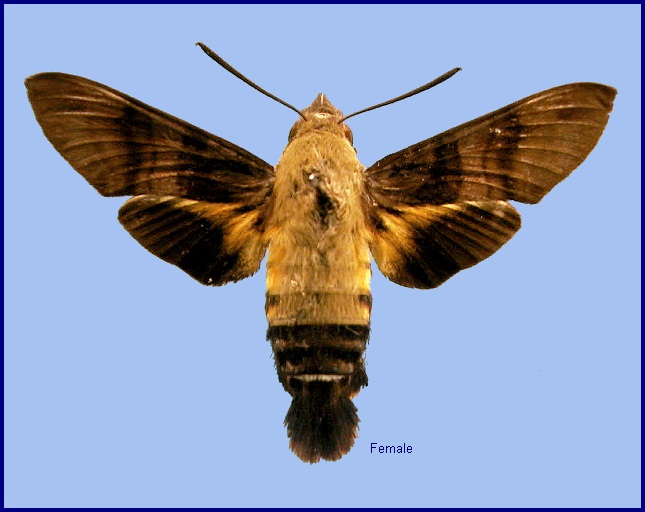
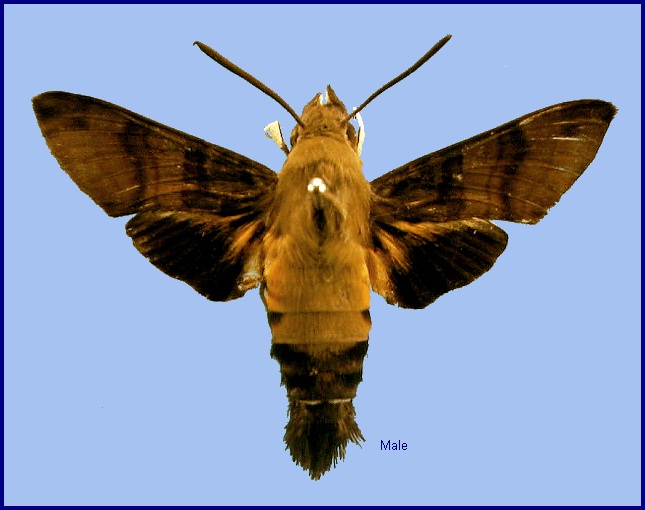
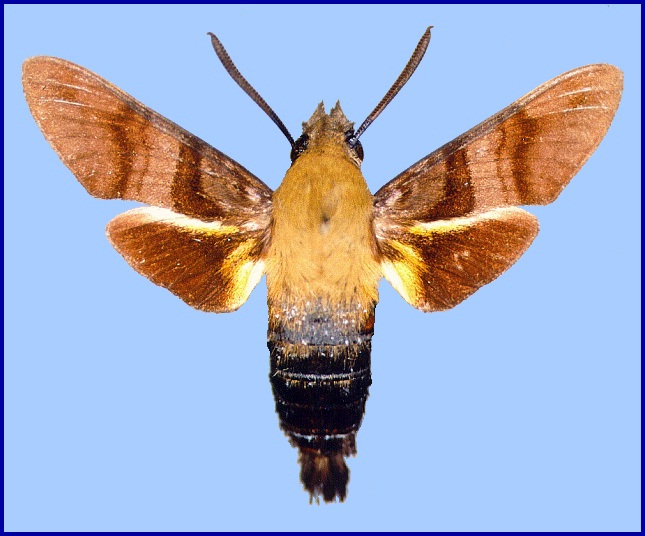
Macroglossa bombylans Boisduval, [1875], in: Boisduval & Guenée, Hist. nat. Insectes (Spec. gén. Lépid. Hétérocères) 1: 334. Type locality: "Asie centrale".
Synonym. Macroglossa tristis Schaufuss, 1870.
Synonym. Macroglossa walkeri Butler, 1875.
Synonym. Macroglossum bombylans angustifascia Bryk, 1944.
Synonym. Macroglossum bombylans monotona (Bryk, 1944).
[Further details on this species in Japan, as well as photos of many stages, can be found on Digital Moths of Japan as well as Moths of the southern Shikoku, Japan.]
Wingspan: 40--52mm. Abdomen upperside with the base of the sixth abdominal tergite, and the side tuft of the third pure white. Thorax underside pure white, with no yellow tint, cf. Macroglossum avicula. Abdomen upperside with proximal two or three sternites with a white mesial patch. In the male, hindwing underside yellow median band reduced to a costal and inner marginal patch; not complete as in the female. In the female, hindwing underside yellow median band more or less complete, not reduced as in the male.
Male genitalia very similar to Macroglossum avicula, but harpe a little more obtuse; phallus with dentate process of considerably shorter.
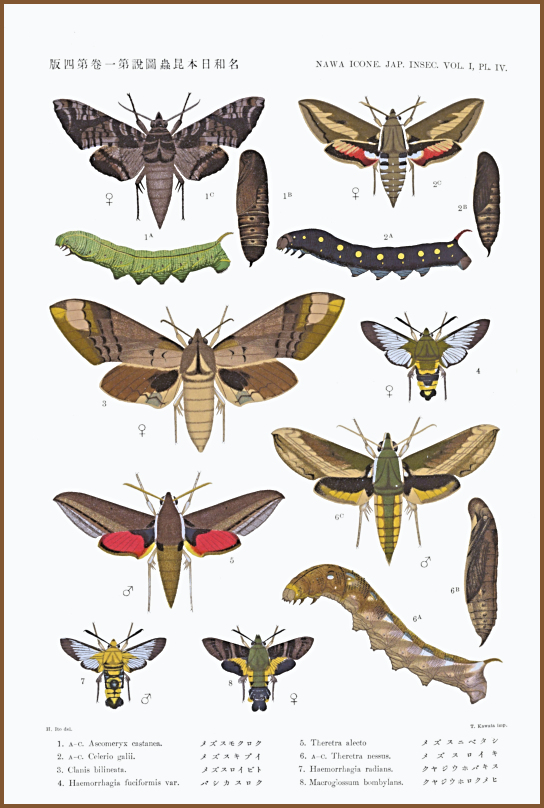
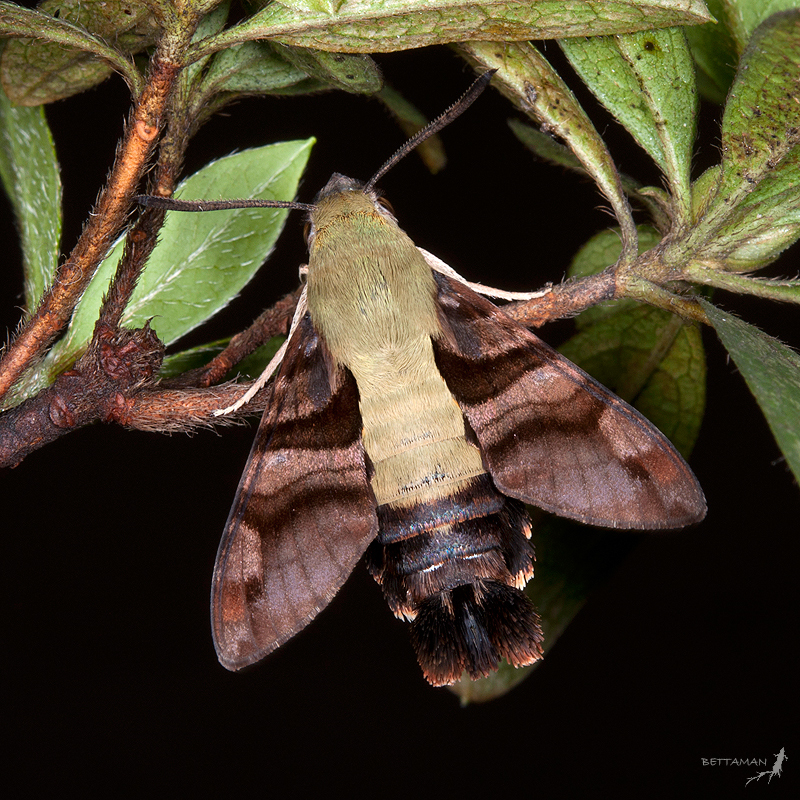
Found at flowers of Barleria cristata and Duranta erecta on Hong Kong (Li, 1992), usually at dawn and late afternoon. Also a minor fruit-piercing pest of yuzu (Citrus junos) in South Korea (Choi, Kim & Lim, 2000).
However, in the Russian Far East this species prefers woodland borders and meadows, as well as areas of burnt and logged woodland, where it flies in the afternoon (Izerskiy, 1999b).
China: vi (Tianjin; Sichuan; Hong Kong; Zhejiang); vi-vii (Guizhou; Sichuan); vii (Shaanxi; Zhejiang; Guangxi; Shandong; Hubei); vii-ix (Chongqing); viii (Yunnan; Guangdong; Zhejiang); ix (Guangdong; Zhejiang); ix-x (Hong Kong); x (Shandong). Taiwan: v (Nantou Hsien; Kaohsiung Hsien); x (Tainan Hsien). Japan: v (Kyushu); 15.vi (Honshu); ix-x (Honshu; Kyushu; Shikoku); 6.x (Shikoku). Russia: 28.vii (Primorskiy Krai).
In northern China there are two generations per year, with adults flying between May and August (Yang, 1978).
Park et al. (1999) give mid July until mid October as the flight period in Korea.
OVUM: Bright green, slightly oval, shiny and smooth (Bell & Scott, 1937).
LARVA: Full-fed 45--50mm, width 7mm, horn 6 mm. According to Bell & Scott (1937), in the first instar green with a straight, black, bifid horn of medium length. In the second instar, head and body green, with a pale subdorsal stripe from segment 2 to base of horn; latter black and of medium length. By the third instar, head dark green with an obscure paler stripe separating face from cheek. Body dark green with an encircling row of small white tubercles around each secondary ring. There is a broad pale green dorsal stripe, with a bluish stripe on each side of it formed of a line of dots on 2 to 6, then continuous to base of horn. There is also a subdorsal line of white tubercles on the same segments, which continues as a broad white stripe to base of horn; a faint subspiracular stripe is present on segments 2 to 12. Horn straight, of medium length, dark purple with black tubercles. In the fourth instar, head dark green with a faint paler stripe down each side of the dorsal line and along sides of clypeus; a second yellowish stripe separates face from cheek. Body paler green. The stripe on each side of the dorsal stripe formed entirely of white dots; subdorsal stripe formed of pale blue tubercles; horn straight, of medium length, blue, with the tip yellow and covered with black tubercles. Legs pale brown; anal flap yellow.
In the fifth instar, shape the same as other Macroglossine larvae; horn straight, of medium length. Head with moderately shiny surface. Body dull with a transverse row of small tubercles around each secondary ring. One tubercle on each ring, on each side of the dorsal stripe, larger than the rest. One tubercle in each row on the dorso-lateral line elongated, spine-like on segments 2 to 6, shorter on the remaining segments to base of horn. Horn covered with small tubercles (Bell & Scott, 1937).
As regards colour, clypeus dark green with a yellow stripe on each side of the dorsal line and along sides of clypeus. There is a yellow stripe separating face from cheek which meets the other stripe at the base of the antenna; the area between the two stripes bright blue; cheek dark bluish-green; antenna reddish. Body: segments 2-4 pale yellowish-green above the spiracles, dark green below them; rest of body pale bluish-green above, the spiracles darker green below them. The tubercles are white except for the dorso-lateral line of spine-like tubercles, which are yellow on segments 2 to 6, paler yellow on the other segments. This line of tubercles bordered below by a bluish-white stripe from 6 to base of horn; a faint pale subspiracular stripe is also present from segment 2 to the claspers. Horn bright blue, tip yellow; tubercles black; legs pink. Spiracles white with a very broad black band across the middle, leaving only a dot at top and bottom white (Bell & Scott, 1937).
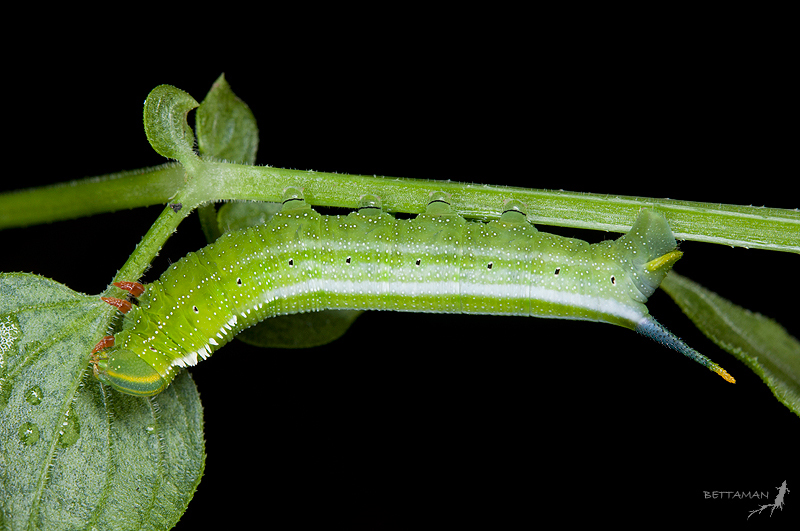
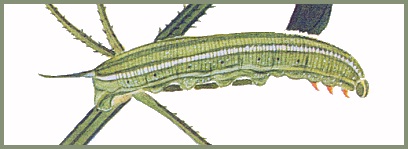
PUPA:
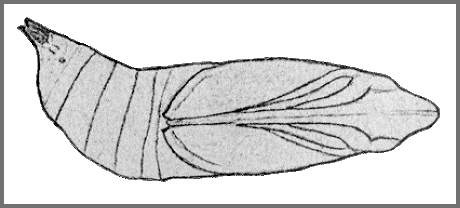
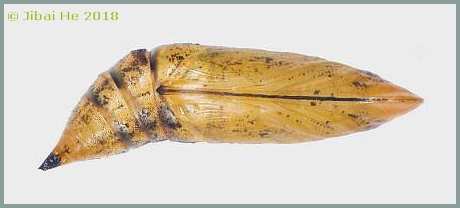
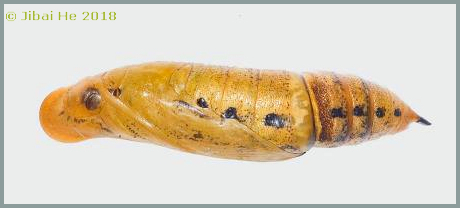
Larval hostplants. Recorded in India on Rubia cordifolia (Bell & Scott, 1937). This is the same host in Taiwan (ShiPher Wu, pers. comm. 2012), where it also feeds on Rubia argyi [syn. Rubia akane] and Rubia alata [syn. Rubia lanceolata].
Recorded in Japan on Rubia argyi (Park et al., 1999) and Galium spurium and, elsewhere, on Paederia and Stauntonia.
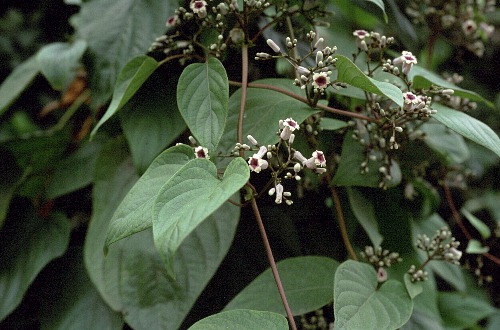
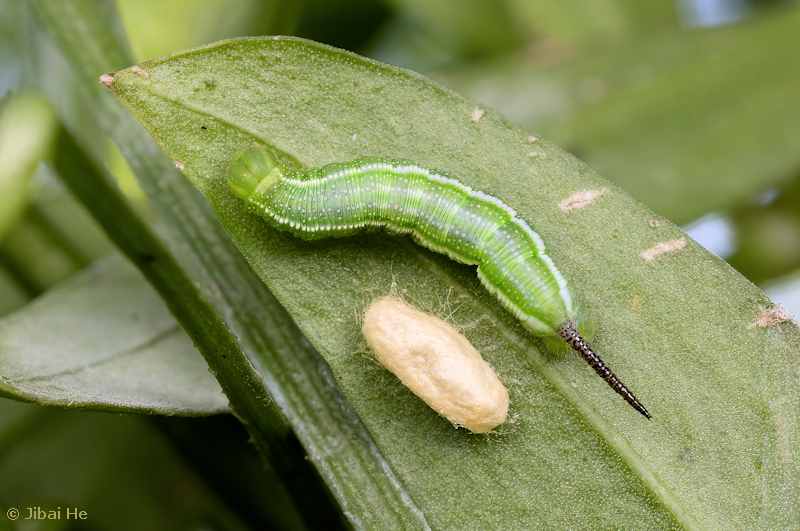
China: Hebei (Zhengding); Beijing (Haidian); Tianjin; Shandong (Qingdao; Jinan; Weihai); Shaanxi (Taibai Shan; Xi'an); Anhui (Mt. Huang Shan); Shanghai; Zhejiang (Tianmu Shan, Jiakou, 1700'; Hangzhou; Kuocang Mountain Nature Reserve); Hubei (Changyang; Zhijiang; Wuhan); Sichuan (Baoxing; Xiaolou; Emei Shan, 3620'; Guan Xian; Kangding; nr. Mianning, 5000'; Chengdu; Dadu He; nr. Guangyuan; Xiling Xueshan National Park; Leshan, 1070'); Chongqing (Fengjie; Nanchuan; Tonggu); Yunnan (Yanmen; Bifengxia, nr. Ya'an); Xizang/Tibet; Guizhou; Hunan (Dayong; Mangshan National Forest Park); Jiangxi (Tiancun, nr. Xingguo); Guangdong (E. Nan Ling; Weizheng; Fengwan); Hong Kong; Guangxi (Jiajiu Shan, Bamian); Hainan.
Taiwan: Tainan Hsien (Kuantzuling); Nantou Hsien (Puli; Dongpu; Chichi); Kaohsiung Hsien (nr. Tuona, 12km SE of Shanping).
South Korea: Kyonggi Province (Gwangleung; Jugeum-san; Daeseong-ri; Asan Bay; Suwon); Kangwon Province (Chiak-san; Donghae); North Chungchong Province (Okcheon); North Cholla Province (Jiri-san; Namwon); South Cholla Province (Baekyang Temple; Mudeung-san; Wolchul-san; Jin-do); North Kyongsang Province (Mungyungsaejae); South Kyongsang Province (Gudeok-san; Pusan; Geumjung-san; Hamyang; Namhae-do; Goseong; Sancheong; Ulsan; Jinyang; Jinju; Hadong); Cheju Province (Cheju-do; Halla-san; Youngsil; Sinsan; Topyung; Ara-dong; Ora-dong; Cheonjiyun; Gyolae-ri; Hallim).
Japan: Hokkaido; Honshu (Nikko; Tokei-ji; Yoshino; Yokohama; Komaba; Kugenuma; Fujisawa; Iruma; Momonoki Spa, 950m; Tokyo); Shikoku (Matsuyama; Mihara); Kyushu (Kagoshima; Hikosan); Tanegashima; Ryukyu Archipelago (Yakushima; Amamioshima).
Russia: Primorskiy Krai (Primorskiy; Vityaz Bay).
From northwestern India (Himachal Pradesh), Nepal, Bhutan (Irungbam & Irungbam, 2019) and northeastern India (Arunachal Pradesh) through China to Taiwan, Korea and Japan, with a few records from the southern Russian Far East. Also northern Thailand, northern Vietnam and the Philippines.
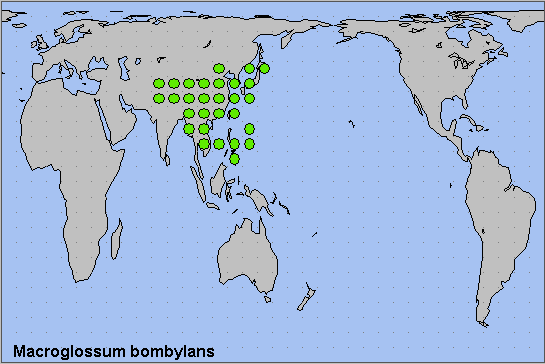
 Return to Sphingidae of the Eastern Palaearctic species list
Return to Sphingidae of the Eastern Palaearctic species list